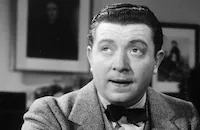One Way Passage

Brief Synopsis
Cast & Crew
Tay Garnett
William Powell
Kay Francis
Aline Macmahon
Frank Mchugh
Warren Hymer
Film Details
Technical Specs

Synopsis
In a Hong Kong bar, Joan Ames and Dan Hardesty literally bump into each other, and fall in love at first sight. Joan goes back to her friends, and without taking his eyes off her, Dan leaves the bar. Outside he is arrested by Steve Burke, a policeman who has been hunting him since he escaped from San Quentin, where he was imprisoned after being convicted of murder. Steve is a sympathetic man and, after Dan saves him from drowning while they are on board a San Francisco-bound ship, agrees to remove his handcuffs. Joan is also aboard the ship, and although she seems healthy, she is actually very ill with only a short time to live. During the voyage, Dan and Joan spend every minute together, and grow to love each other deeply. They develop a ritual of breaking their glasses after a drink to symbolize their desire to live in the moment. Dan cannot bear to tell Joan the truth about himself, but while she plans a trip ashore in Honolulu, he plans to escape. Expecting just such an attempt, Steve locks Dan in the brig. Barrel House Betty, a confidence woman posing as a countess, decides to help Dan out. Flirting with Steve, she gets the key to the brig and passes it to Skippy, a petty thief escaping from the Chinese police, who releases Dan from the cell. Steve and Betty go ashore, as do Joan and Dan. After a romantic day, Dan is about to tell Joan about his planned escape when she collapses. To save her life, Dan gives up his last chance at freedom and carries her back to the ship. The doctor warns him that another shock could kill Joan, so he keeps his secret. Steve and Betty have also fallen in love. When Steve asks her to marry him, Betty tells him who she really is, but Steve doesn't change his mind. Joan learns the truth about Dan when she overhears a ship's porter talking, but says goodbye to Dan, pretending that everything is fine. They agree to meet in Caliente on New Year's Eve even though they know that this is impossible. At midnight on New Year's Eve, a bartender in Caliente hears a sound and turns to find the shattered stems of two glasses, broken in the same way that Dan and Joan always broke them, but no one is there.

Director

Tay Garnett
Cast

William Powell

Kay Francis

Aline Macmahon

Frank Mchugh

Warren Hymer
Frederick Burton
Douglas Gerrard

Herbert Mundin
Roscoe Karns
Dewey Robinson
Stanley Fields
Willie Fung
Crew

Photo Collections
Videos
Movie Clip


Trailer
Hosted Intro
Film Details
Technical Specs

Award Wins
Best Writing, Screenplay
Articles
One Way Passage
An expert tearjerker, One Way Passage (1932) was the sixth teaming of Powell and Francis and proved to be their biggest commercial hit. They were first paired at Paramount when the studio realized their on-screen chemistry together and a string of successful melodramas followed: Behind the Make-Up, Street of Chance, For the Defense (all 1930), and Ladies Man (1931). Unfortunately, Paramount couldn't keep up with their salaries and both stars were lured away from that studio and given exclusive contracts with Warner Bros. They starred in two more features there: Jewel Robbery and this film, One Way Passage (both 1932). Yet strangely, despite the box-office success of both films, Warner's never paired them again. Powell's disillusionment with the studio wasn't long in coming as he soon left for MGM and hit his full stride in 1934 with the hits The Thin Man and Manhattan Melodrama. As for Francis, her career sadly faded as a second lead at Warner Bros. and by the 1940s, she was relegated to working at Monogram studios. For years, Francis was considered by some film historians as simply a "clothes horse" due to her glamorous wardrobe in most of her early films. Yet recently, there has been renewed interest in this star who created the prototypical "suffering in mink" heroine, the sort of role that was later popularized by stars Bette Davis and Joan Crawford. Francis also excelled as free-thinking, independent women in such pre-Code fare as Mary Stevens, MD (1933) and Mandalay (1934).
Despite the soap opera aspects of Robert Lord's script, it says much that the film is still enjoyable by today's standard due to the polish of Tay Garnett's direction, an excellent roster of character players like the venerable Frank McHugh and Aline MacMahon, and of course, the performances of Powell and Francis. The film was remade in 1940 as 'Til We Meet Again with George Brent and Merle Oberon, but it wasn't nearly the hit that One Way Passage was. It just proves that a potent on-screen chemistry between two romantic leads is the key to the success of a film like One Way Passage.
Producer: Robert Lord, Hal B. Wallis
Director: Tay Garnett
Screenplay: Tay Garnett (uncredited), Joseph Jackson, Robert Lord (story), Wilson Mizner
Cinematography: Robert Kurrle
Costume Design: Orry-Kelly
Film Editing: Ralph Dawson
Original Music: W. Franke Harling, Bernhard Kaun
Cast: William Powell (Dan Hardesty), Kay Francis (Joan Ames), Frank McHugh (Skippy), Aline MacMahon (Countess Barilhaus), Warren Hymer (Steve Burke)
BW-68m.
By Michael Toole

One Way Passage
Quotes
Trivia
Notes
The film's working title was S.S. Atlantic. Writer Robert Lord received an Academy Award nomination for Best Original Story. In his autobiography, director Garnett remembers writing the treatment from Lord's original idea, but says he refused credit and was not recognized with an Oscar. Modern sources list Ruth Hall and Allan Lane in the cast. According to modern sources the film did so well at the box office that Warner Bros. remade it in l940 as 'Til We Meet Again (see below).

















